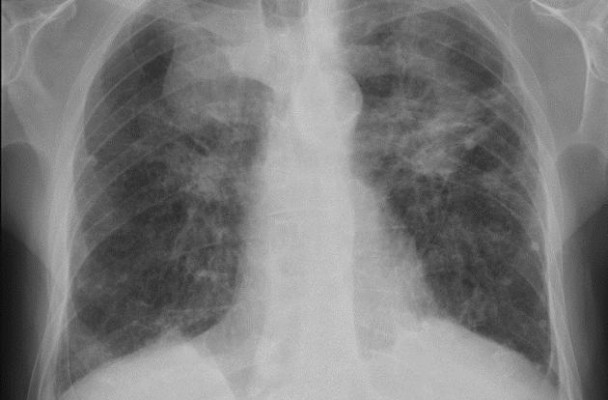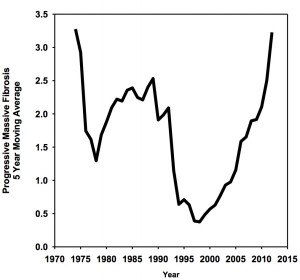NIOSH Study Shows Resurgence of Black Lung Disease Among Working Appalachian Coal Miners

A lung x-ray of a miner with Progressive Massive Fibrosis (PMF), the most severe form of black lung.
New research from the National Institute of Occupational Safety and Health (NIOSH) has found that the rate of the most severe form of black lung among Appalachian coal miners has resurged to the same rate it was before the federal government started regulating coal mine dust levels 45 years ago.
The new data shows that rates of Progressive Massive Fibrosis (PMF) have “boomeranged” in the region, stoking concerns of mining methods, coal mine dust levels, and enforcement. The release of the data also comes on the heels of the Mine Safety and Health Administration’s renewed attempts to curb coal mine dust levels.
The takeaway from this new data is probably best conveyed in a chart, shown below, that shows the U-shaped curve of PMF rates. While the chart itself is appalling, what’s worse is that it shows five-year moving averages. Therefore the recent raw numbers are even more grim and show that the risk of catching severe black lung is actually worse for miners today than it was in 1969.

In 2012, the prevalence of severe black lung, known as progressive massive fibrosis, in miners in West Virginia, Virginia and Kentucky reached 3.2%, up from a low of 0.4% in 1998. In 1974, the level was 3.3% for miners in those states.
As a matter of epidemiology, we shouldn’t see this under the dust limits that have existed since 1970. It shows that loopholes in the law, in addition to underenforcement of dust laws, have eviscerated the protections that as a nation we promised our miners in 1969.
The government has already taken some action in the right direction, but this action is threatened by industry and Congress. Earlier this year, the federal Mine Safety and Health Administration revised the dust regulations to close some loopholes and, in 2016, to lower the permissible level of dust. This new rule is being challenged in court by the coal industry and some members of Congress are threatening to strip MSHA’s funding in response.
We at Appalachian Citizens’ Law Center are very concerned about what this data shows. According to Wes Addington, the Center’s deputy director, “This data is truly frightening. A decade ago it would have been unimaginable that we would see rates of severe black lung back up to 1960s levels. We have broken our promise to protect our miners.”
In addition to overexposure and lack of enforcement, many miners in central Appalachia are working in different conditions than existed 20 or 30 years ago. Thinner coal seams mean that miners are breathing dust from sandstone and shale formations, in addition to coal dust. Also miners now work longer hours, with twelve hour shifts now being the norm.
According to Evan Smith, an attorney at ACLC, “We have noticed that more of our clients have complicated coal workers’ pneumoconiosis, but this data shows that we’ve only seen the tip of the iceberg. Black lung is a latent and progressive disease and we expect to see miners suffering from black lung for decades to come. Severe cases of black lung should not exist in the 21st Century, but this data shows its actually worsening.”
8 Responses to “NIOSH Study Shows Resurgence of Black Lung Disease Among Working Appalachian Coal Miners”
[…] has also been drawn to the bill after data published recently by the National Institute of Occupational Safety and Health showed a resurgence of the most severe form of black lung disease among Appalachian coal […]
[…] has also been drawn to the bill after data published recently by the National Institute of Occupational Safety and Health showed a resurgence of the most severe form of black lung disease among Appalachian coal […]
[…] disease. And to add to these frustrations, the risk of catching the most severe form of black lung is actually worse for miners today than it was in 1969, two years before this comic book was […]
[…] United States isn’t the only country dealing with a black lung epidemic. A recent report from the Wall Street Journal documents the soaring rate of black lung disease in […]
[…] form of black lung known as “complicated coal workers’ pneumoconiosis,” despite current epidemiological data showing that 3.2% of Central Appalachian career miners have complicated…. Dr. Wheeler also criticized the standard films that are used as points of comparison. […]
[…] coal miners’ testimony about dust fraud in Blankenship’s trial with data covered in previous posts showing an upsurge in black […]
[…] notable that the weight of the evidence supported a diagnosis of complicated pneumoconiosis. As severe black lung is surging back in Central Appalachia it is striking that a person such as Mr. Pennington who spent little time in a traditional coal […]
[…] done research into the resurgence of black lung (for examples of Dr. Blackley’s research, see here, here, here, and […]
Comments are closed.